Fabric medium, a secret weapon in the artist’s arsenal, is a transformative solution for those seeking to paint on fabric with acrylics.
This specialized medium unlocks a realm of creative possibilities, enhancing adhesion, flexibility, and color retention, ultimately ensuring the longevity of textile-based artworks.
With its unique composition of acrylic polymers, the fabric medium maintains the natural drape and softness of fabrics, preventing stiffness. Its compatibility with a diverse range of textiles, from cotton to silk, provides artists with a versatile tool for various projects.
This introduction explores the essential role fabric medium plays in elevating textile arts and crafts, offering a gateway to dynamic and enduring creations.
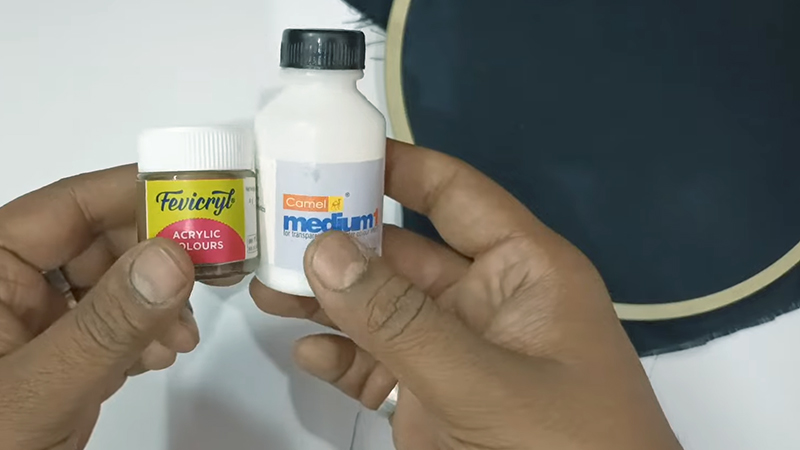
What Is a Fabric Medium?
Fabric medium is a specialized solution used in textile arts and crafts to enhance the workability and durability of acrylic paints on fabric.
It is essentially an acrylic polymer emulsion that, when mixed with acrylic paints, creates a more flexible and adhesive mixture suitable for painting on fabric.
Here are some key aspects of fabric medium:
Adhesion and Flexibility
Fabric medium plays a crucial role in improving the bond between acrylic paint and fabric fibers. Without it, acrylic paint may not adhere properly, leading to a higher risk of flaking or peeling, especially after repeated use or washing.
Additionally, the added flexibility ensures that the paint can withstand the natural movements and stretches that fabrics often undergo.
Reduces Stiffness
One of the common drawbacks of using acrylic paint directly on fabric is the potential for a stiff or rigid texture. This can make the fabric uncomfortable to wear or handle.
Fabric medium counteracts this issue, allowing the paint to retain the fabric’s original softness and pliability. This is particularly important for garments or home textiles where comfort is a priority.
Maintains Colorfastness
Over time, exposure to light, water, or repeated washing can cause colors to fade. Fabric medium acts as a protective barrier, helping to preserve the vibrancy and intensity of the paint.
This ensures that your artwork on fabric remains visually appealing and retains its original brilliance even with regular use and cleaning.
Minimizes Bleeding
When working with multiple colors or intricate designs, preventing colors from bleeding into each other is crucial for achieving clean and precise lines.
Fabric medium helps to stabilize the paint, reducing the likelihood of colors spreading beyond their intended boundaries. This is particularly valuable for detailed or intricate designs.
Versatility
Fabric medium is highly versatile and compatible with a wide range of textiles. Whether you’re working on natural fibers like cotton or silk, or using synthetic fabrics, fabric medium can be applied effectively.
This versatility makes it a go-to choice for artists and crafters working on various fabric-based projects.
Application
The process of using fabric medium involves mixing it with acrylic paint prior to application. The specific ratio may vary based on the brand or type of fabric medium being used, so it’s crucial to follow the manufacturer’s guidelines for the best results.
This ensures that the paint and medium are properly integrated, maximizing their combined benefits.
Drying Time
The drying time of paint mixed with fabric medium is typically similar to that of regular acrylics.
However, it’s important to allow sufficient time for the paint to thoroughly dry and bond with the fabric. Proper drying is essential to ensure the longevity and durability of the painted design.
Compatibility
Fabric medium is often compatible with other acrylic mediums, offering artists the opportunity to experiment with different textures, effects, and finishes.
This versatility allows for a wide range of creative possibilities, from adding texture to creating glossy or matte finishes.
Washing and Care
After the paint has dried, it’s crucial to heat-set it using an iron or fabric dryer. This process helps to ensure that the paint adheres securely to the fabric. Once heat-set, fabric painted with fabric medium is generally washable.
However, it’s advisable to follow specific care instructions provided by the manufacturer to maintain the longevity of the artwork.
Varieties
There is a diverse selection of fabric mediums available, each with its own unique properties and applications.
Some may be specially formulated for specific types of fabric or techniques, providing artists with options to choose from based on their project requirements and creative preferences.
It’s worth exploring different varieties to find the one that best suits your artistic endeavors.
Composition of Fabric Medium
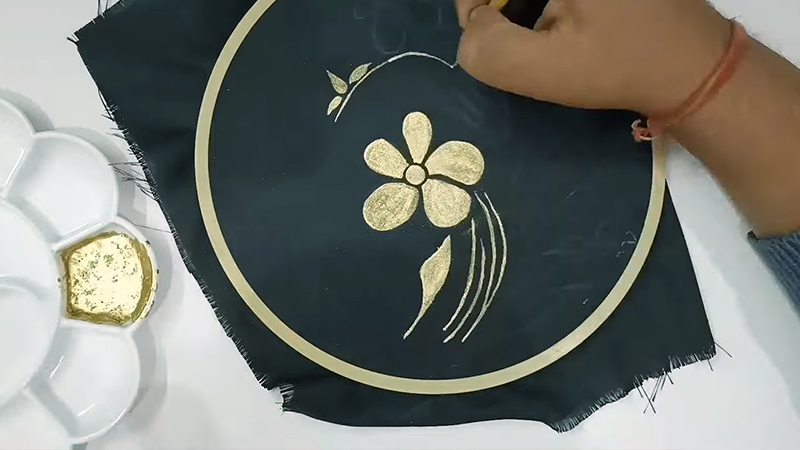
Fabric Medium is primarily composed of an acrylic polymer emulsion, which is a water-based solution containing acrylic polymers. These polymers are the same type of binding agents found in acrylic paints.
Here is a breakdown of the basic components typically found in fabric medium:
Acrylic Polymers
These are the main components of fabric medium. They are responsible for providing adhesion, flexibility, and durability to the acrylic paint when applied to fabric. Acrylic polymers are versatile and known for their ability to adhere well to various surfaces.
Water
Fabric medium is a water-based solution, which means it contains a significant portion of water. This serves as a carrier for the acrylic polymers, allowing them to be evenly distributed and applied to the fabric.
Surfactants
Surfactants are compounds that help to lower the surface tension of the liquid, allowing it to spread more easily over the fabric. They also aid in the even distribution of the acrylic polymers, ensuring a smooth application.
Stabilizers
These additives are included to maintain the stability and consistency of the fabric medium. They help prevent the separation of the components and ensure that the medium remains homogenous.
Antimicrobial Agents
Some fabric mediums may contain antimicrobial agents to prevent the growth of mold or bacteria within the medium. This can be especially important for preserving the quality of the product over time.
pH Adjusters
Depending on the specific formulation, the fabric medium may contain pH-adjusting agents to ensure that the solution remains within a certain pH range. This helps maintain the stability and effectiveness of the medium.
How to Apply Fabric Medium?
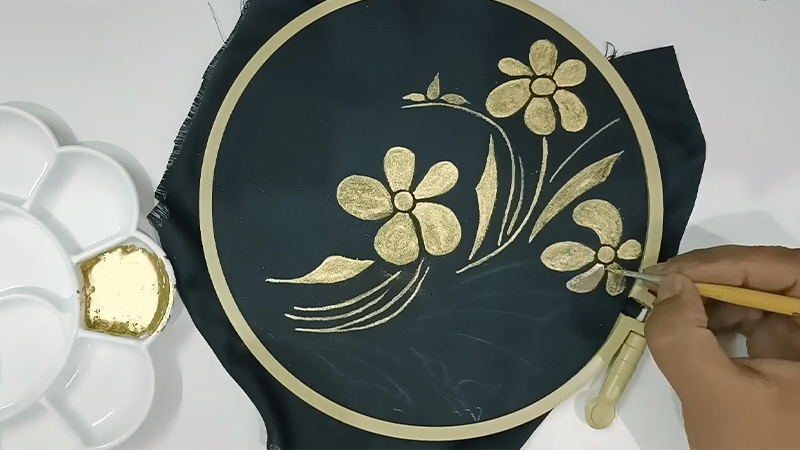
The application of fabric medium is a crucial step in using acrylic paints on fabric effectively.
When used correctly, fabric medium enhances the paint’s adhesion to the fabric, maintains flexibility, and prevents stiffness.
Here’s how to apply fabric medium to achieve the best results:
Gather Your Materials
- Acrylic paint
- Fabric medium
- Fabric or textile to be painted
- Paintbrushes or other application tools
- Palette or mixing container
- Water (for cleaning brushes)
Mixing
Start by preparing your acrylic paint colors. Squeeze out the desired amount of acrylic paint onto a palette or into a mixing container.
Then, add the fabric medium to the paint. The typical starting point is roughly equal parts fabric medium and acrylic paint, but you can adjust this ratio to achieve your desired level of transparency, texture, or flexibility.
Thorough Mixing
Using a clean stirring stick, palette knife, or a brush, thoroughly blend the fabric medium and acrylic paint. Ensure that they are well incorporated to create a consistent mixture.
Testing
Before applying the mixture to your fabric, conduct a small test on an inconspicuous area or a separate piece of fabric. This allows you to evaluate how the paint interacts with your fabric and how it appears when dry.
Application
With your mixture ready, begin painting your design onto the fabric using brushes or other painting tools.
Pay attention to the consistency of the paint to ensure even coverage across the fabric. For detailed work, consider using fine brushes, stencils, or other tools for precision.
Drying Time
Allow the painted fabric to air dry for the recommended time, which is usually similar to regular acrylic paint drying times.
Keep in mind that drying times may vary based on the thickness of the paint application and environmental conditions. It’s crucial to ensure the paint is completely dry before proceeding.
Heat Setting
To make the paint permanent and washable, you’ll need to heat-set it. This is typically done by ironing the painted fabric.
Place a pressing cloth, like a thin piece of cotton fabric, over the painted area to protect it from direct contact with the iron. Set the iron to a cotton setting without steam and apply gentle pressure for a few minutes.
Washing and Care
After the heat setting, your fabric should be washable. However, always refer to the specific care instructions provided by the manufacturer of the fabric medium and the paint for best results.
In general, using a gentle cycle and cold water is advisable for washing fabric painted with fabric medium to prolong its lifespan.
Benefits of Using Fabric Medium
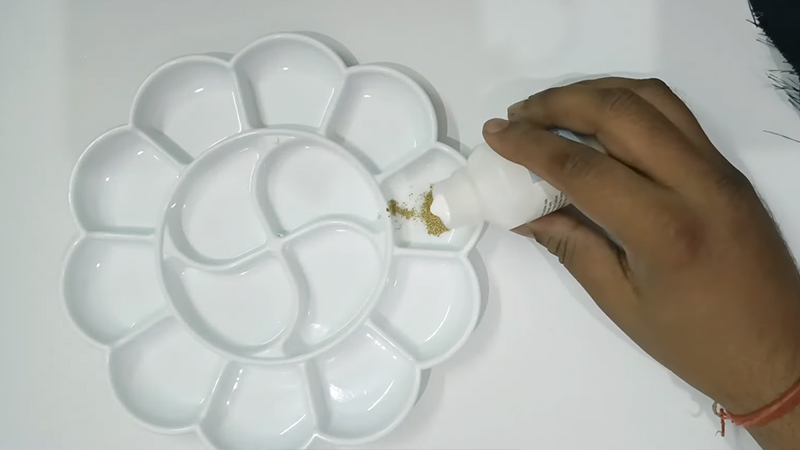
Using fabric medium offers a range of benefits for artists and crafters working with acrylic paints on fabric. These advantages enhance the quality, longevity, and versatility of painted fabric projects.
Here are the key benefits of incorporating fabric medium:
Improved Adhesion
Fabric medium enhances the adhesion of acrylic paint to fabric fibers. This ensures that the paint adheres securely, reducing the likelihood of flaking or peeling, even after repeated use or washing.
Flexibility and Softness
Without fabric medium, acrylic paint on fabric can sometimes result in a stiff or crunchy texture.
The addition of fabric medium maintains the natural drape and softness of the fabric, making it comfortable to wear or handle.
Reduced Bleeding
Fabric medium helps stabilize the paint, minimizing the tendency of colors to bleed into one another.
This is especially important for achieving clean and precise lines in detailed or intricate designs.
Maintained Colorfastness
Fabric medium acts as a protective barrier, preserving the vibrancy and intensity of the paint colors.
This ensures that the artwork on fabric remains visually appealing and retains its original brilliance, even with regular use and washing.
Versatility
Fabric medium is compatible with a wide range of textiles, including cotton, linen, silk, and synthetic fabrics. This versatility allows artists to work on various fabric-based projects with confidence.
Prevents Stiffness
The use of fabric medium counteracts the potential for acrylic paint to create a rigid or crunchy texture on fabric. This is particularly important for garments or home textiles where comfort is a priority.
Facilitates Detailed Work
Fabric mediums can help maintain the integrity of fine lines and intricate details in designs, allowing artists to create complex and precise artwork on fabric.
Allows for Layering and Blending
The added flexibility and improved adhesion provided by fabric medium allow for layering and blending of colors, enabling artists to achieve a wider range of visual effects and gradients.
Resists Cracking
When applied to fabric, acrylic paint mixed with fabric medium is less likely to crack or peel over time.
This helps to maintain the integrity of the artwork, even with regular wear and washing.
Compatibility with Other Acrylic Mediums
Fabric medium is often compatible with other acrylic mediums, providing artists with the opportunity to experiment with different textures, effects, and finishes in their fabric projects.
Easy to Use
Incorporating fabric medium into acrylic paint is a straightforward process that requires no special skills or equipment. It can be easily integrated into an artist’s existing toolkit.
Creative Possibilities with Fabric Medium
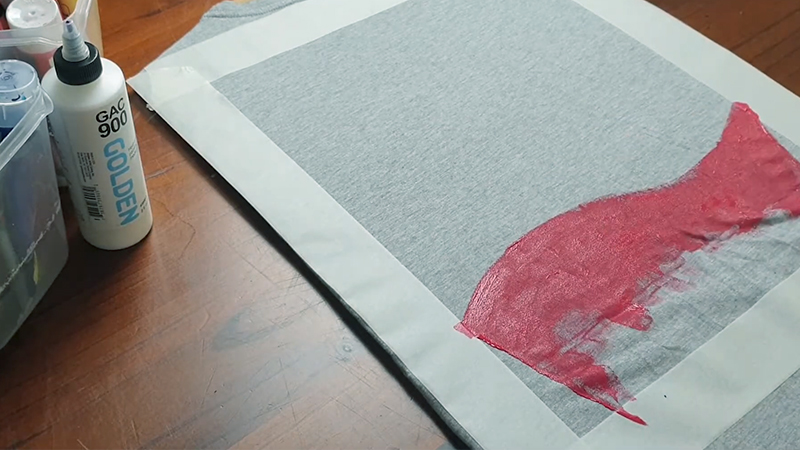
Fabric Medium opens up a wide array of creative possibilities for artists and crafters working with acrylic paints on fabric.
Here are some of the exciting avenues it offers:
Custom Apparel and Fashion
Artists and designers can unleash their creativity by crafting unique clothing and fashion items.
Fabric medium allows for custom designs on t-shirts, dresses, scarves, hats, and more. With fabric medium, you can transform plain garments into wearable works of art.
Home Decor
Fabric medium opens up a realm of possibilities for enhancing home decor.
Artists can create personalized touches for their living spaces by adding custom designs and patterns to pillow covers, curtains, tablecloths, and napkins. It’s an excellent way to infuse individual style into interior design.
Textile Art and Fiber Arts
For artists interested in textile and fiber art, fabric medium provides a versatile medium for creating intricate and detailed pieces.
This includes the production of wall hangings, tapestries, quilts, and fabric sculptures that can convey powerful visual narratives and evoke emotions.
Handbags and Accessories
With fabric medium, you can elevate your handbags, purses, and accessories from plain to spectacular.
Customizing accessories allows you to showcase your unique style and creativity, making a fashion statement that stands out.
Custom Gifts
There’s no better way to show someone you care than by giving a personalized gift.
Fabric medium enables you to craft one-of-a-kind gifts for special occasions like birthdays, weddings, and anniversaries. Personalized gifts are memorable and meaningful.
Cosplay and Costuming
Cosplayers and costume enthusiasts can take advantage of fabric mediums to add intricate details, textures, and designs to their costumes. This level of precision and creativity can help bring characters to life with authenticity and style.
Mixed Media Art
Fabric medium can be integrated into mixed media art, offering a range of textural and visual possibilities.
It can be combined with other mediums like embroidery, beading, or appliqué to create layered and visually rich compositions.
Fabric Printing and Stamping
Incorporate fabric medium into stamping and printing techniques to create beautiful patterns and designs on fabric. This opens up endless possibilities for fabric artists who enjoy experimenting with textures and motifs.
Children’s Crafts
Fabric medium is safe for use by children and can be included in a variety of crafting projects.
It’s perfect for making custom t-shirts, decorating fabric tote bags, and engaging young artists in creative exploration.
Upcycling and Refashioning
Artists and crafters can give new life to old or plain clothing and textiles by using fabric medium with acrylic paint to create unique and trendy fashion pieces. Upcycling allows you to minimize waste while maximizing style.
Themed Events and Parties
Fabric medium can be a valuable tool for creating custom decor and accessories for themed parties.
This ensures a cohesive and visually appealing event, from decorations to personalized party favors.
Personalized Nursery and Children’s Room Decor
Fabric medium enables artists to create custom bedding, curtains, and wall art for nurseries and children’s rooms.
Tailored to specific themes or color schemes, these pieces can transform children’s spaces into imaginative and welcoming environments.
Holiday and Seasonal Decor
Embrace the festive spirit by using fabric medium to create customized holiday decor.
Whether it’s Christmas, Halloween, Easter, or other holidays, fabric medium allows you to design table linens, stockings, and ornaments that capture the essence of the season.
Customized Upholstery
Artists can add artistic designs to fabric-covered furniture or upholstery using fabric mediums.
This not only transforms functional pieces into unique and eye-catching centerpieces but also allows for the expression of personal style in home furnishings.
Tips for Using Fabric Medium Effectively
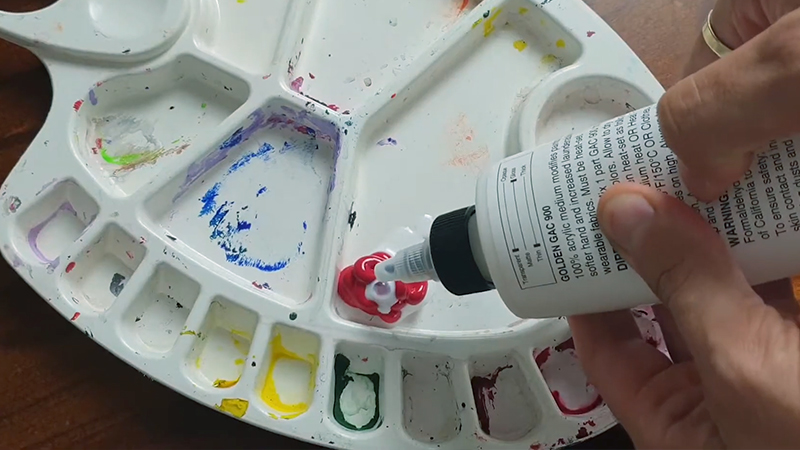
When using fabric mediums, it’s essential to keep a few key tips in mind to ensure that your fabric painting project is successful.
Here are some valuable tips for using fabric medium effectively:
Preparing Your Workspace
Before you start painting, ensure that your workspace is clean and well-ventilated.
Lay down protective coverings to prevent accidental spills and splatters on surfaces, and have access to water for cleaning brushes.
Mixing Ratios Matter
Pay attention to the recommended mixing ratios for fabric medium and acrylic paint.
While a 1:1 ratio is a common starting point, the exact ratio may vary depending on the brand and product you’re using. Refer to the manufacturer’s guidelines for the best results.
Test on a Scrap Fabric
Prior to painting your main project, conduct a test on a scrap piece of fabric. This allows you to assess how the fabric medium interacts with your chosen textile and how the colors appear when dry.
Consistency Is Key
Achieving the right paint consistency is crucial. Too thick, and the paint may crack or become stiff; too thin, and it may bleed or appear faded.
Adjust the mixture until you achieve a consistency that works for your specific project.
Dry Thoroughly Before Heat-Setting
Ensure that the painted fabric is completely dry before attempting to heat-set it.
The drying time is typically similar to regular acrylic paints, but factors like humidity and thickness of application can affect it. Patience is key.
Heat-Set Properly
To make the paint permanent and washable, follow the heat-setting process diligently. Use an iron set to the cotton setting without steam, and place a pressing cloth (a thin piece of cotton fabric) between the iron and the painted area.
Apply gentle pressure for several minutes to bond the paint to the fabric effectively.
Wash and Care with Caution
After heat-setting, your fabric should be washable. However, it’s essential to follow the specific care instructions provided by the manufacturer for the best results.
In general, use a gentle cycle and cold water to extend the lifespan of the artwork.
Use Quality Brushes
High-quality paintbrushes can make a significant difference in achieving fine details and smooth coverage.
Invest in brushes designed for acrylics, which tend to have durable bristles that won’t shed during painting.
Be Mindful of Color Layering
When you plan to layer colors, consider the transparency of the paint mixture.
Some colors may become more transparent when mixed with fabric medium, so plan your layering and blending accordingly.
Experiment and Get Creative
Don’t be afraid to experiment with different techniques and effects. Fabric mediums can be mixed with other acrylic mediums and used in combination with stencils, stamps, or texture pastes to create unique and visually appealing fabric art.
FAQs
What is a fabric medium?
A fabric medium is a specialized solution used in textile arts and crafts to enhance the workability and durability of acrylic paints on fabric.
What can a fabric medium do?
A fabric medium can improve the adhesion, flexibility, and colorfastness of acrylic paint on fabric.
Can I use fabric medium on any type of fabric?
Yes, the fabric medium is designed to be compatible with a wide range of textiles, including natural fibers like cotton and silk, as well as synthetic fabrics.
Do I need to heat-set fabric painted with fabric medium?
Yes, it’s crucial to heat-set fabric painted with fabric medium.
Can fabric medium be mixed with other acrylic mediums?
Yes, fabric medium is often compatible with other acrylic mediums, allowing for experimentation with different textures, effects, and finishes in fabric projects.
To Recap
A fabric medium is a vital tool for artists and crafters working with acrylic paints on fabric.
Its unique formulation of acrylic polymers enhances adhesion, flexibility, and colorfastness, making it indispensable for creating durable and vibrant designs on textiles.
By reducing stiffness and minimizing color bleeding, fabric medium ensures a comfortable, long-lasting finish. Its versatility extends to various fabric types, allowing for creative expression on cotton, silk, and synthetic materials.
With proper application and heat-setting, fabric medium transforms ordinary fabrics into canvases for intricate artwork.
This versatile medium empowers artists to explore a wide range of textile projects, from clothing to home decor, with exceptional results.
Leave a Reply